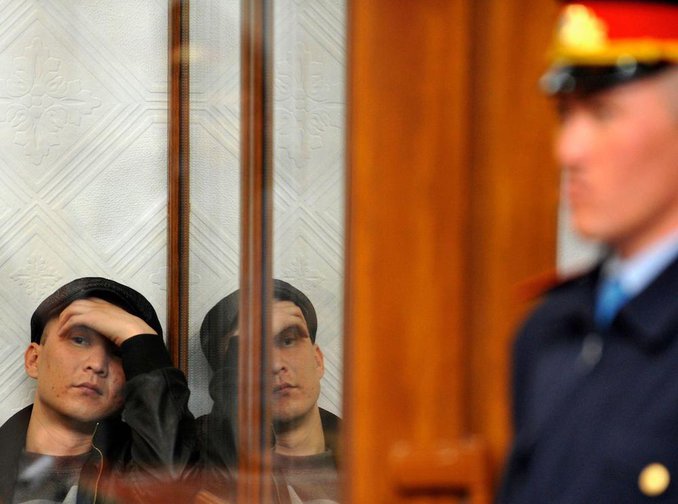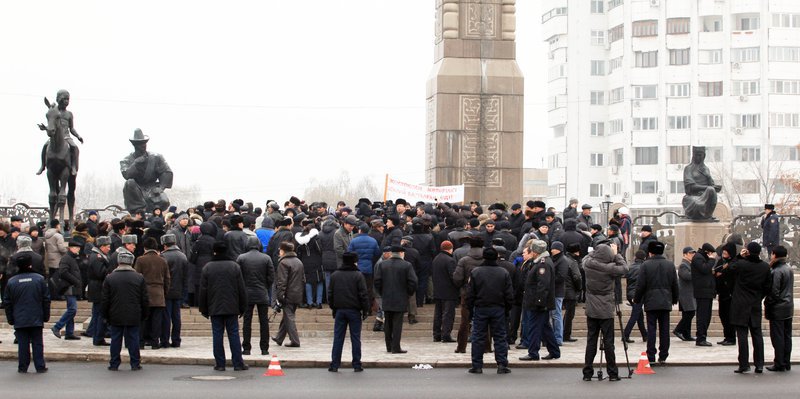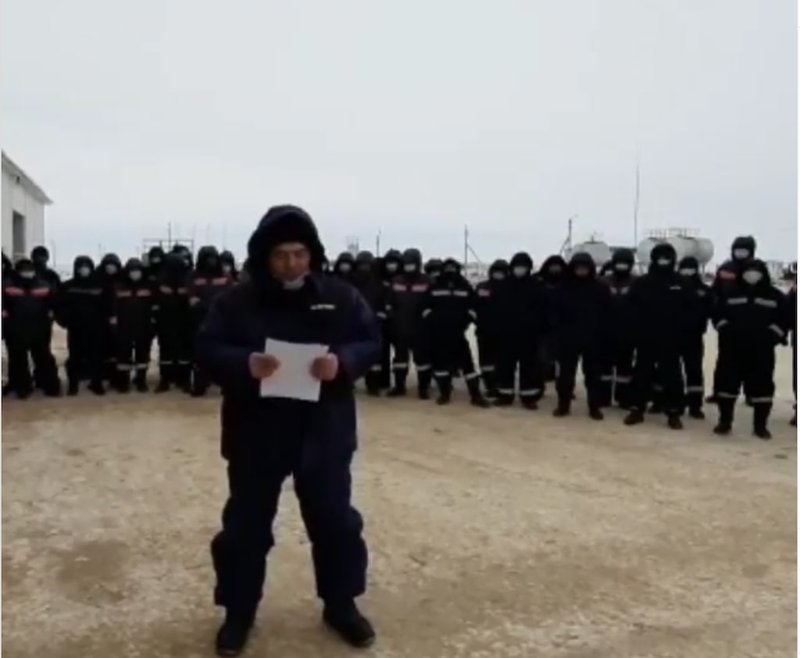Oil workers are stepping up their battle for independent union organisation and better pay and conditions in the shadow of state repression and a 2011 massacre
Simon Pirani
16 December 2021

Thirteen demonstrators were convicted in the aftermath
of the massacre at Zhanaozen |
(c) REUTERS / Alamy Stock Photo. All rights reserved
Ten years after police massacred striking oil workers in Zhanaozen, Kazakhstan, human rights organisations and trades unionists are demanding an international inquiry into the killings.
Even now, the true number of victims is unknown. State officials admit that 16 people were killed and 64 injured on 16 December 2011 – but campaigners say there were dozens, perhaps hundreds, more.
The initial killings – by Kazakhstani law enforcement who fired into a peaceful, unarmed crowd – were followed by a three-day reign of terror in Zhanaozen, a town in the oil-rich Mangistau province in western Kazakhstan, and nearby villages.
The torture and sexual violence used against detainees should also be investigated by an independent international commission, campaigners say
Although a handful of police officers were tried for “exceeding their powers”, and a detention centre boss briefly jailed, the Kazakh government has refused to say who ordered the shootings. Thirty-seven protestors stood trial in their aftermath, and 13 were convicted.
Eight-month strike
The Zhanaozen shootings ended an eight-month strike by the town’s oil workers, one of the largest industrial actions ever in Central Asia.
Oil workers and their families had demanded better pay and conditions, and the right to organise independent trade unions, at Ozenmunaigaz, a production subsidiary of the national oil company KazMunayGas, and contracting firms.
Zhanaozen has become a crucial strand in Kazakhstani working people’s collective memory. On the day of the killings, local residents risked arrest and worse to smuggle out video clips from the locked-down city, showing how demonstrators were executed in cold blood.
(c) REUTERS / Alamy Stock Photo. All rights reserved
Ten years after police massacred striking oil workers in Zhanaozen, Kazakhstan, human rights organisations and trades unionists are demanding an international inquiry into the killings.
Even now, the true number of victims is unknown. State officials admit that 16 people were killed and 64 injured on 16 December 2011 – but campaigners say there were dozens, perhaps hundreds, more.
The initial killings – by Kazakhstani law enforcement who fired into a peaceful, unarmed crowd – were followed by a three-day reign of terror in Zhanaozen, a town in the oil-rich Mangistau province in western Kazakhstan, and nearby villages.
The torture and sexual violence used against detainees should also be investigated by an independent international commission, campaigners say
Although a handful of police officers were tried for “exceeding their powers”, and a detention centre boss briefly jailed, the Kazakh government has refused to say who ordered the shootings. Thirty-seven protestors stood trial in their aftermath, and 13 were convicted.
Eight-month strike
The Zhanaozen shootings ended an eight-month strike by the town’s oil workers, one of the largest industrial actions ever in Central Asia.
Oil workers and their families had demanded better pay and conditions, and the right to organise independent trade unions, at Ozenmunaigaz, a production subsidiary of the national oil company KazMunayGas, and contracting firms.
Zhanaozen has become a crucial strand in Kazakhstani working people’s collective memory. On the day of the killings, local residents risked arrest and worse to smuggle out video clips from the locked-down city, showing how demonstrators were executed in cold blood.

December 2011: Residents of Almaty, Kazakhstan, protest in reaction to police brutality in Zhanaozen |
(c) ITAR-TASS News Agency / Alamy Stock Photo. All rights reserved
On Saturday 11 December this year, oil workers gathered in Zhanaozen, amidst a heavy police presence, to commemorate the victims. Tomorrow, ten years to the day after the tragedy, activists plan film screenings and other gatherings in Almaty, Kazakhstan’s largest city.
Today, some of the fear has faded, activists say: whole films – such as this one, made in 2013 – are shared on social media.
On Saturday 11 December this year, oil workers gathered in Zhanaozen, amidst a heavy police presence, to commemorate the victims. Tomorrow, ten years to the day after the tragedy, activists plan film screenings and other gatherings in Almaty, Kazakhstan’s largest city.
Today, some of the fear has faded, activists say: whole films – such as this one, made in 2013 – are shared on social media.
Who fired the shots?
An international investigation is needed because, even now, the Kazakhstani authorities are desperate to cover up the truth, according to two human rights activists who have investigated the massacre.
Evgeny Zhovtis, director of the Kazakhstan International Bureau for Human Rights and the Rule of Law, said that there were “three questions that have never been answered” about the events on the town’s central Alan Square, where the initial shootings took place:
Who were the provocateurs who caused trouble on the square?
Who exactly gave the order to send in armed police against an unarmed crowd?
Who fired the shots? The authorities have admitted to 15 killings on the square. In each case, under Kazakhstani law, an investigation should show either that the officer responsible had opened fire unlawfully, or that he opened fire because his life was threatened.
Zhovtis pointed out that two UN commissioners had called for an independent international commission to investigate the Zhanaozen events, but “this has not happened”.
Human rights defenders in Kazakhstan reject the Justice Ministry’s claim that an adequate investigation had been carried out, Zhovtis said.
“The leading Western governments are largely indifferent to what happens in central Asia,” he added. “Look at their response both to the Zhanaozen tragedy and the Andijan massacre [of hundreds of protesters in Uzbekistan in May 2005].”
Galym Ageleuov of human rights organisation Liberty has travelled regularly to Zhanaozen since the massacre to gather evidence. He said that, in addition to the events on Alan Square, any investigation should cover the use of torture against oil workers and their supporters detained during the three-day crackdown, sexual violence against women detainees and further alleged extrajudicial killings by security forces.
Kazakhstan’s labour movement is marking the Zhanaozen tragedy at a time when the right to form independent trade unions is again at issue in many workplace struggles
Detailed evidence of torture had already been made public, including at the trial of the 37 Zhanaozen protestors in 2012. “There is evidence that women and men prisoners were detained naked [in winter], were beaten, and had freezing water poured on them,” Ageleuov said.
Ageleuov also pointed to evidence of sexual violence against women detainees, including an oil workers’ trade union organiser and daughters of trade union activists.
Finally, he expressed dissatisfaction with the official death toll, referring to multiple reports of bodies being loaded into unmarked graves – including by Elena Kostyuchenko of Novaya Gazeta, Russia’s foremost opposition newspaper, one of the first journalists to get into Zhanaozen after the massacre.
“Any international commission should insist on the exhumation of these bodies,” Ageleuov said.
Long memories
Kazakhstan’s labour movement is marking the Zhanaozen tragedy at a time when the right to form independent trade unions, a key principle in the 2011 oil workers’ strike, is again at issue in many workplace struggles.
In June, national oil company KazMunayGas tried to scrap an agreement on wages and conditions with the independent Oil Construction Company Workers Union, seeking instead a sweetheart deal with a ‘union’ it had created itself. This followed an attempt by the authorities to deregister, and effectively put beyond the law, the independent Sectoral Union of Fuel and Energy Workers, a national-level umbrella of which the Oil Construction Company Workers Union is part.
Markhaba Khalmurzaeva, coordinator of the Central Asia Labour Rights Monitoring Mission, said: “There have been several strikes in which workers demanded the right to independent organisation, and in some cases, once a pay dispute was settled, employers even helped to register unions.”
But there is also a constant campaign of repression. “Quite often a strike will be settled, some demands are met, but activists who played a part in organising it are dismissed, and blacklisted,” Khalmurzaeva said.
These battles for the right to independent union organisation flared up earlier this year amidst a wave of strikes over pay and conditions. There were more strikes in the first half of 2021 than in the whole three years from 2018 to 2020. And this summer, the wave hit the western Kazakhstan oilfield, including Zhanaozen, where 11 firms were on strike simultaneously in July.

Worker at AMK Munai makes appeal to Kazakhstani president Kassym-Jomart Tokayev | Source: Instagram / EurasiaNet
In Zhanaozen, in the years after the massacre, the Ozenmunaigaz oil company was reorganised into 14 separate divisions. Many of the strikers were employed in the drilling services division, where pay was raised substantially and today is at more than twice the level of ten years ago.
In an attempt to smother the social discontent that exploded in 2011, the Kazakhstani government has invested in the town’s infrastructure, providing among other things round-the-clock water supply, where previously water only reached people’s homes for short periods twice a day.
Zhanaozen’s population has also expanded, but not everyone has benefited. Unemployment has grown rapidly, and in 2019 young people began to demonstrate at the local authorities’ offices, demanding work at Ozenmunaigaz. One man, Erzhan Elshibayev, who helped to organise these peaceful gatherings, was arrested and imprisoned for five years.
Ageleuov called the case against Elshibayev an instance of “political repression”, pointing to the fact that the organiser was convicted over a street fight that had happened two years before his arrest.
“Elshibayev has been in detention for two years. For the last three months he has been in solitary confinement and no one has heard from him,” he said.
Ten years after the Zhanaozen massacre, labour’s battles against capital continue in western Kazakhstan’s oilfields: for better pay and living conditions, for the right to organise independently at work, and for ways to live decently.
Exposing the truth about Kazakhstani state repression in 2011, about the chain of command, and about the barbaric use of murder and torture in the service of capital is part of this wider struggle.
A longer version of this article originally appeared at People and Nature.
In Zhanaozen, in the years after the massacre, the Ozenmunaigaz oil company was reorganised into 14 separate divisions. Many of the strikers were employed in the drilling services division, where pay was raised substantially and today is at more than twice the level of ten years ago.
In an attempt to smother the social discontent that exploded in 2011, the Kazakhstani government has invested in the town’s infrastructure, providing among other things round-the-clock water supply, where previously water only reached people’s homes for short periods twice a day.
Zhanaozen’s population has also expanded, but not everyone has benefited. Unemployment has grown rapidly, and in 2019 young people began to demonstrate at the local authorities’ offices, demanding work at Ozenmunaigaz. One man, Erzhan Elshibayev, who helped to organise these peaceful gatherings, was arrested and imprisoned for five years.
Ageleuov called the case against Elshibayev an instance of “political repression”, pointing to the fact that the organiser was convicted over a street fight that had happened two years before his arrest.
“Elshibayev has been in detention for two years. For the last three months he has been in solitary confinement and no one has heard from him,” he said.
Ten years after the Zhanaozen massacre, labour’s battles against capital continue in western Kazakhstan’s oilfields: for better pay and living conditions, for the right to organise independently at work, and for ways to live decently.
Exposing the truth about Kazakhstani state repression in 2011, about the chain of command, and about the barbaric use of murder and torture in the service of capital is part of this wider struggle.
A longer version of this article originally appeared at People and Nature.
No comments:
Post a Comment